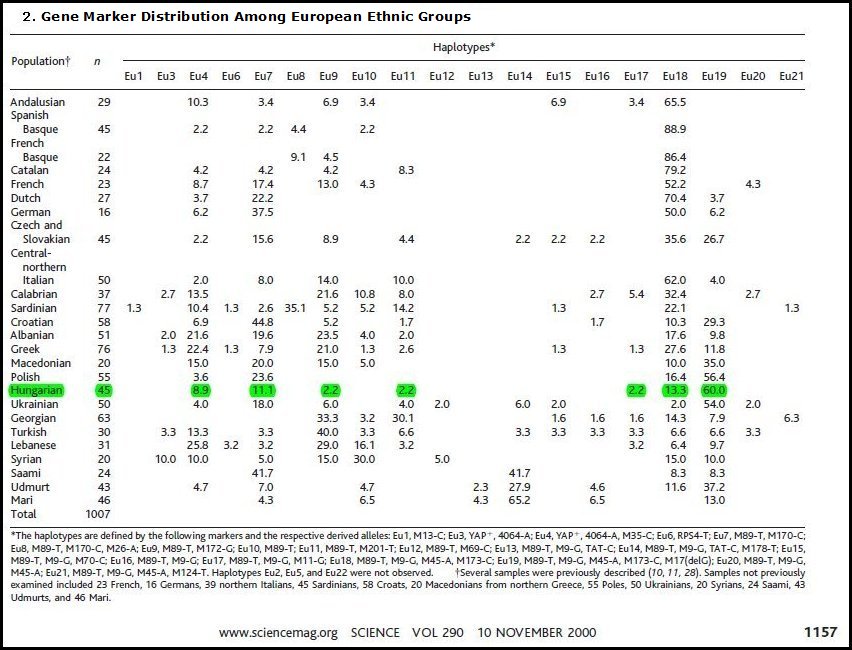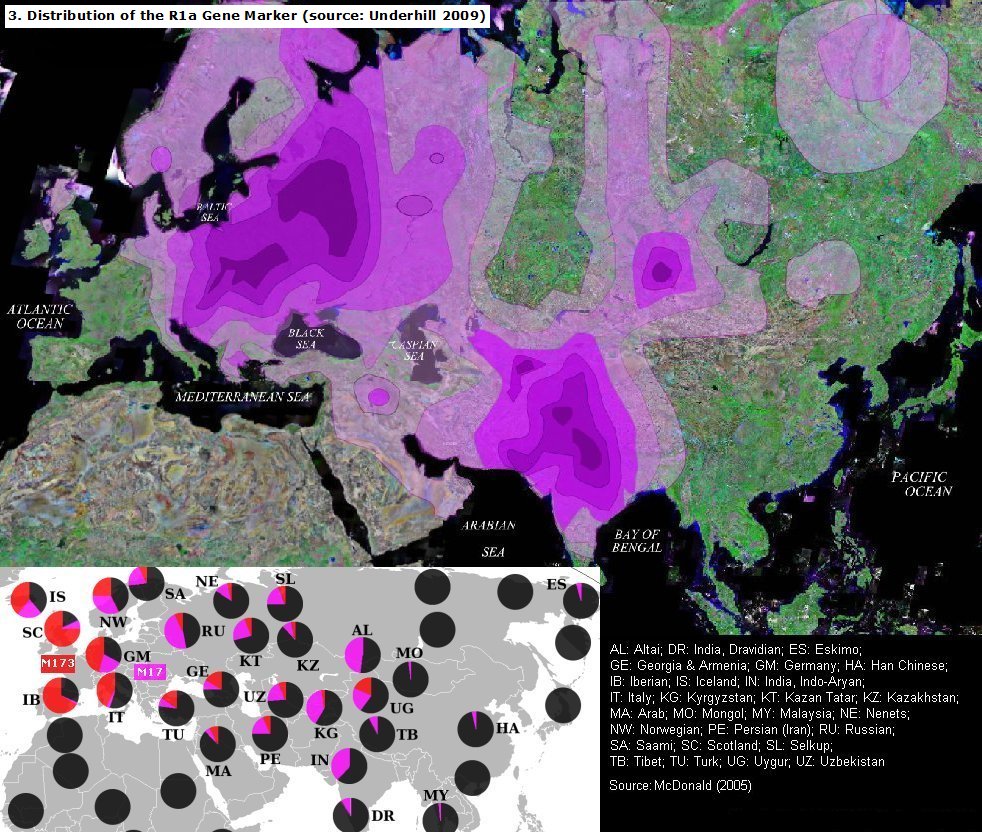TURANIAN ORIGINS: THE GENETIC EVIDENCEAccording to recent genetic research (Semino, 2000), the analysis of the Y-chromosome gene markers across Eurasia indicates that the peoples having the M173 (Eu18) gene marker have been in Europe for approximately 40 000 years and are the most ancient group in Europe. Before them there were Neanderthals who disappeared about 30 000 years ago, and who may have been partially absorbed by the Cro-Magnoid humans with the M173 gene marker. Approximately 20 000 years ago, during the ice age, the M17 (Eu19)* gene marker group evolved from the M173 gene marker group in the Carpathian Basin and the neighbouring Central and Eastern European regions. The M17 (Eu19) gene marker occurrence has been recorded at its highest within the Hungarian population (60% - 1. & 2.). It is important to note that the M173 (Eu18) and M17 (Eu19) gene markers are found in 50% of the current European male population, and that their occurrence is highest in two non-Indo-European ethno-linguistic groups: the Basques (Eu18) and the Hungarians (Eu19). This means that the groups carrying the M173 (Eu18) and M17 (Eu19) gene markers represent the most ancient European populations, and that the Indo-European peoples and languages only formed later from the intermingling of these ancient populations with other ethno-linguistic groups who came later to Europe. This genetic research also indicates that the genetic markers most characteristic of the Hungarian population are also present in significant proportions elsewhere in Central and Eastern Europe, as well as Central and South-Western Asia, and this distribution corresponds to the known movements of the Turanian Scythian and Hunnic peoples during ancient times based on the historical, archeological, anthropological, and ethnographic evidence, thus substantiating the Hungarian-Scythian, Scythian-Hun and Hun-Magyar ethno-linguistic connections. A significant presence of the M17 (Eu19) gene marker has been found in the human genetic material recovered from ancient Scythian burial sites in Siberia, as well as in the present-day Turkic populations of Sibera and Central Asia (Altay, Kazakh, Kirgiz, Tatar, Uygur, Uzbek, etc.) who are also descendants of the Huns. This further confirms the Scythian-Hun-Magyar-Turkic ethno-linguistic relationship. The genetic evidence also indicates that the genetic markers most characteristic of the Finno-Ugrians of Northern Europe, the Volga-Ural region, and Siberia (Eu13 and Eu14) are completely absent in the Hungarian population. However, the M17 (Eu19) gene marker is also present in varying proportions in the various Finno-Ugrian groups. Based on the latest linguistic, archeological, anthropological, and genetic research, Hungarians are therefore not of Finno-Ugrian origin, but the Finno-Ugrian ethno-linguistic groups were formed under the dominant ethno-linguistic and cultural influence of the Turanian (Scythian and Hunnic) peoples with whom the Finno-Ugrians came in contact, thus explaining the Hungarian-Uralic linguistic correlation. Similar correlations and explanations also apply in the case of the Slavic and other peoples of Central and Eastern Europe whose populations show high proportions of the M17 (Eu19) gene marker characteristic of the Hungarians and of other Turanian peoples: the genetic profile of the Central and East European peoples clearly show that these ethnic groups have formed through the absorbtion of significant numbers of Turanian peoples throughout history. This means that the ethnic groups currently known as Bavarians, Moravians, Austrians, Slovaks, Poles, Ukrainians, Russians, Rumanians, Bulgarians, Serbians, and Croatians, just to name the main ones, are to a significant extent genetically constituted of various Turanian ethnic groups such as the Scythians, Huns, Avars, Cumans, Petchenegs, Khazars, Sabirs, Onogurs, Turks, and Tatars (above 50% in the case of the Poles, Ukrainians, and Russians). * The M17 and Eu19 gene marker designations have been replaced in later genetic research by the R1a designation and its variants. © HUNMAGYAR.ORG | Latest Update: 2021.12.03 |



Index | Next page: Ancient Turanians | Turanian History Page